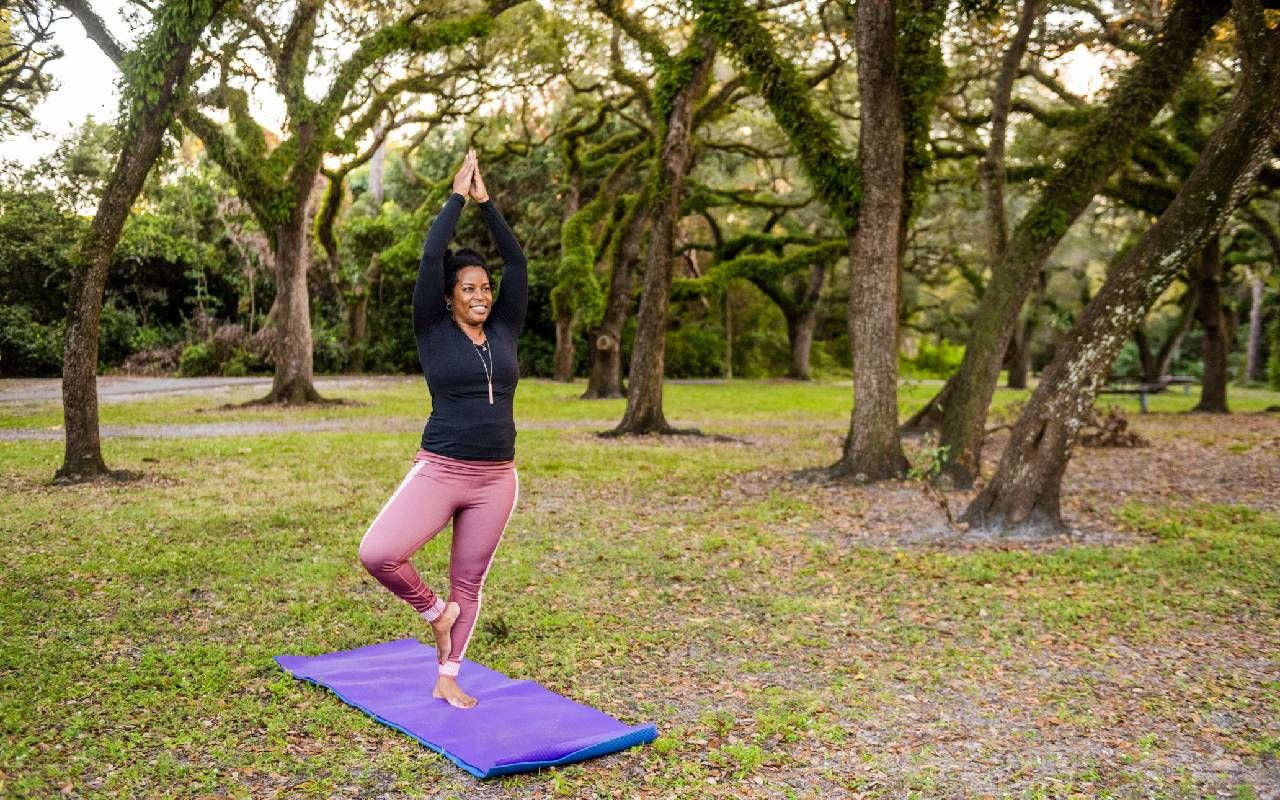Don't Wait to Focus on Balance
Assessing and strengthening balance is essential before it becomes problematic
Strength, balance and flexibility are the dynamic trio at the heart of healthy aging. All three are necessary to remain physically strong, safe and independent as long as possible.
With a growing emphasis on the importance of strength training for older adults, balance is often assumed to be good enough until it becomes a problem.

There are excellent reasons, however, to address balance proactively. According to the Centers for Disease Control and Prevention, the number of deaths from falls in adults ages 65 and older increased by 41% over the decade from 2012 to 2021, and falls cause 3 million hospital visits and 1 million hospital stays for older adults each year.
Balance begins to decline after age 50 and a recent study observed that balance worsens significantly every five years, starting around 55.
Balance begins to decline after age 50, and a recent study observed that balance worsens significantly every five years, starting around 55. The same study found that the inability to balance on one leg for 10 seconds later in life was associated with a greater risk of death from all causes.
According to Dan Sivertson, physical therapist, founder and clinic director of Pure Form Physio in Langley, Canada, "You have to start putting investments in your system now, so you have something to draw on as you age. Sometimes, you're going to take big draws because you're in bed for a month with an illness, injury or surgery. You want to have a strong balance in the bank, so when you need to make withdrawals, you've got it."
But First, What's Balance?
Having good balance means staying on your feet while standing still (static balance) and moving (dynamic balance). Alongside the strength your muscles need to hold your bones upright, three complex systems work together to keep you balanced: the inner ear, or vestibular system; the eyes, or vision system; and the somatosensory or proprioceptive system, which allows you to feel where your body is in space.
Falls cause 3 million hospital visits and 1 million hospital stays for older adults each year.
Dr. Brett Maddux, DPT, is an outpatient orthopedics physical therapist in Camarillo, California, who sees primarily geriatric patients. "The good news is the systems are largely trainable. If one is weakened, we can either strengthen it or strengthen the others around it," he says. "It takes effort, though. We live in a society of instant gratification, and people want things quickly. I tell my patients to see improvement, they need to work on it just about every day."
If you live an active lifestyle, taking your balance for granted is easy. Spending a few moments assessing your balance can help strengthen weak areas and keep you on your feet for years. Sivertson puts it bluntly: "You don't get many chances at falls before one is catastrophic. In your 70s and 80s, you might get away with a few, but eventually, one will be life-altering or life-ending."
Testing Your Balance
If you are concerned about your balance, it's essential to speak with your doctor, who can determine the cause and refer you to a physical therapist. If you feel like your balance is strong but are curious about how strong, here are four tests you can try at home.
For each test, ensure you are near a wall, kitchen counter or the back of a couch for support. If you are worried about falling, only do these tests with the help of a clinician.
- The Romberg Balance Test: With your shoes off and your feet together, cross your arms over your chest and hold the position for 60 seconds without moving your feet or reaching for support. If you remain steady, repeat with your eyes closed. You're now relying on your strength, inner ear and proprioception without the aid of your vision. If you pass the test quickly, proceed to the Sharpened Romberg Test.
- The Sharpened Romberg is done with feet in a tandem or heel-to-toe position, as though you're on a balance beam. This narrows your base of support, making the test more challenging. Again, passing the examination means you can stand with your arms crossed over your chest without moving for 60 seconds, first with your eyes open, then with your eyes closed. Switch the position of your feet and do the test again, noticing if having one foot in front is harder. Don't despair if you can't complete this test. Try the next two and begin to train your balance with the suggestions below.
- Stand on one leg for 15-30 seconds. Switch and stand on the other leg for the same length of time. If you feel steady, repeat the exercise, slowly turning your head from side to side while balancing.
- The Five Times Sit to Stand Test measures balance control and lower body strength. Start by sitting in a straight-backed chair with arms crossed over your chest. Have someone time you as you move from sitting to standing five times as quickly as you can, making sure you stand and sit fully. There are age-related speeds you can compare your time to, and if it takes longer than 15 seconds or you cannot finish the test, you are at greater risk of a fall.
Talk with your doctor if you're concerned about your results in any of the above tests. A physical therapist can use more complex assessment tools, like the Dynamic Gait Index and the Berg Balance Scale, to examine your balance more fully.
Improving Balance
Now that you've assessed your balance, it's time to incorporate balance training into your daily life. "To get better balance," Sivertson explains, "you have to do active exercises. You cannot get it through massage, manipulation, adjustment or acupuncture. There's no pill for it. It's hard work and repeated exposure to challenges to your system. But it can be fun!"
"If they are able to tolerate it, I always encourage people to walk barefoot in the house."
There are numerous ways to make balance training a part of your daily life, ranging from simple exercises to more strenuous activities.
Practice standing on one foot:
- Take 15-30 seconds to stand on each foot while brushing your teeth, putting on socks, or watching TV.
- To increase the challenge to your proprioceptive system, stand on a medium-density foam pad for at least 30 seconds, starting with both feet and progressing to one foot at a time.
- To engage your vision system differently, stand on one foot and toss a tennis ball gently into the air, catching it with the other hand.
- Find a partner and stand on one foot, on the floor, or on a foam pad while gently tossing a ball back and forth between you for 30 seconds at a time.
Walking is excellent for balance, especially outdoors, where surfaces aren't perfectly smooth. "We want healthy people to rely less on their vision for balance," Maddux explains, "so if someone is walking on an even surface and it's clear there's nothing dangerous in the way, I would encourage them to walk with their eyes level instead of looking down at their feet."
Maddux also recommends walking barefoot at home. "If they are able to tolerate it, I always encourage people to walk barefoot in the house, as it's one way to maintain the proprioception and mobility in your feet and ankles."
Both Maddux and Sivertson emphasize the importance of strength training to keep muscles and bones strong alongside activities that push you to stabilize your body as it moves through space, such as Tai Chi, yoga and Pilates, all of which have positively impacted balance.
Maria Leone, Balanced Body Master Teacher and owner of Bodyline Pilates Studio in Beverly Hills, explains, "We are constantly working on stability and posture while moving and applying weight via body weight as well as resistance via springs."
She adds, "My oldest client is about to turn 94. She walks unassisted, does her grocery shopping, even jumps on the reformer."
According to Sivertson, many falls occur as older adults lose their balance when reaching for something. "Pickleball, tennis and playing frisbee are great ways to strengthen your body's ability to reach."
Sivertson also calls walking barefoot in the sand "a buffet for your nervous system. It's challenging and makes different muscles work."
For healthy adults, hiking, surfing, skiing, cycling and dancing will help keep balance strong.
Finally, Maddux recommends retro walking, or walking backward, which research shows is highly beneficial to balance.
"It decreases your reliance on vision, and challenges the somatosensory system. You're getting two benefits in one activity," he explains. It can help to walk with a friend, taking turns walking backward so one of you can keep an eye out for obstacles.
The good news is it's never too late to improve balance, but it does get more challenging with age. Focusing on it proactively can be an enjoyable addition to an active, healthy lifestyle.


